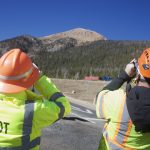Ask Eartha: What is the Summit County Resource Allocation Park?
Ask Eartha

High Country Conservation Center/Courtesy photo
Dear Eartha, Can someone please explain to me the difference between the landfill and the Summit County Resource Allocation Park? I’ve heard both terms used to describe the same place, but aren’t they different?
I can understand your confusion, as these words are often used interchangeably. The fact is, the landfill and “the SCRAP” are the same place. SCRAP stands for Summit County Resource Allocation Park. As the name implies, much more goes on there than just handling trash. Yes, there is a landfill, but there are also programs for recycling and composting.
The SCRAP team is passionate about what they do, working to ensure that we are diverting as much waste away from the landfill as possible. Here’s a closer look at what goes on at Summit County’s landfill and recycling facility.
Summit’s single landfill
The SCRAP is home to Summit County’s one and only landfill that serves approximately 30,000 residents, as well as all of the tourists who visit our beautiful mountain community. Everything we throw into a trashcan ends up in the SCRAP landfill. While it is a common misconception that materials in landfills break down, landfills are actually designed to bury trash — not to decompose it.
Our landfill is currently projected to be full by 2078. So, before you throw it away, make sure your waste cannot be composted or recycled. By keeping waste out of the landfill, we can extend its life and save us all money.
Two recycling facilities and a new recycling drop-off center
All recyclables that are collected at the free recycling centers or that are picked up curbside by local haulers are taken to the SCRAP’s Materials Recovery Facility (MRF). Recyclables are then sorted and baled for shipment. The bales of single stream recycling end up at Waste Management’s MRF in Denver. When they arrive, the bales are broken apart, and the recyclables are eventually purchased by companies that turn them into new products. It’s important that we follow local recycling guidelines to ensure the efficiency and cost effectiveness of the sorting and baling process. If you’re curious to learn more about what happens to your recycling once it’s baled for shipment, check out the previous “Ask Eartha: What Happens to Your Recycling.”
Hard to recycle items and household hazardous-waste materials like paint, appliances and clothing are also accepted at the SCRAP at no cost to residents. If you’re unsure whether or not your waste is recyclable, you can reference the recycling tool at HighCountryConservation.org.
Be sure to check out the new free recycling center at the SCRAP. The new facility accepts everything that the other drop-sites do, like plastic and cardboard, as well as scrap metal, old clothing and more.
The Compost Pad
In the United States, approximately 63 million tons of food is wasted each year and locally, food waste accounts for roughly 21% of all material landfilled in Summit County. Even though landfills aren’t designed to decompose garbage, food waste tossed in a landfill will break down through a process called anaerobic decomposition. It’s anaerobic because the landfill is an oxygen-poor environment. This type of decomposition generates methane, a potent greenhouse gas that contributes to climate change by trapping heat in the atmosphere. What’s a better alternative? Composting!
The High Country Compost Pad is where food scraps from homes, schools, and businesses are diverted from the landfill. The scraps are combined with biosolids recovered from wastewater treatment plants that have been treated to meet strict environmental and health standards and wood chips from beetle-killed pine trees and transformed into compost. Compost is cool because it adds nutrients to your lawn and garden and helps the soil retain moisture, which is critical in our dry climate. You can learn more about the free residential food scrap program or how to purchase local compost by visiting HighCountryConservation.org.
The SCRAP and you
As Summit County residents, whether you are a passionate environmentalist or not, the limited lifespan of the landfill impacts us all. This is why increasing access to recycling has been such a priority for the SCRAP and our community. It’s why we have free recycling centers, why several towns have adopted policies that increase recycling, and why High Country Conservation Center encourages all residents and businesses to compost. Join me in doing our part to waste less, recycle more, compost our food scraps and encourage others to do so as well.
To learn more about ways you can help extend the life of the landfill, visit HighCountryConservation.org or SummitCountyCo.gov/scrap.
Ask Eartha Steward is written by the staff at the High Country Conservation Center, a nonprofit dedicated to waste reduction and resource conservation. Submit questions to Eartha at info@highcountryconservation.org.


Support Local Journalism

Support Local Journalism
As a Summit Daily News reader, you make our work possible.
Summit Daily is embarking on a multiyear project to digitize its archives going back to 1989 and make them available to the public in partnership with the Colorado Historic Newspapers Collection. The full project is expected to cost about $165,000. All donations made in 2023 will go directly toward this project.
Every contribution, no matter the size, will make a difference.









